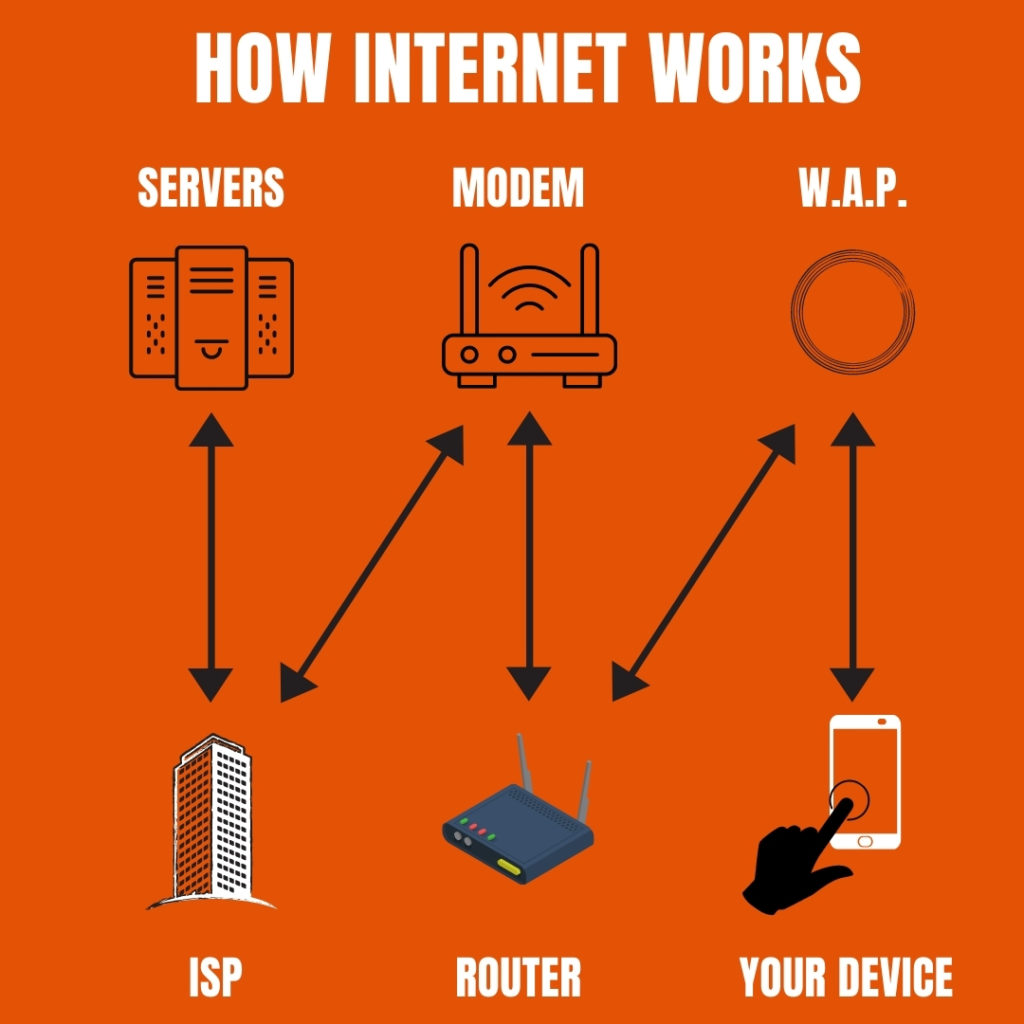How does the internet work?
You might be sitting on your phone right now. Or maybe you’re on your computer. If you’ve ever asked yourself the question, “How does the internet work,” this article will break down the process. Read along for an explanation of the inner-working of the internet and how you access it so easily.
A Quick History on the internet.
- 1962 – MIT, J.C.R. Licklider spoke about the Galactic Network concept, “the internet.”
- 1969 – The first message was sent over the internet from one computer to another via ARPANET.
- 1982 – First emoticon was as smiley face “:-)”
- 1989 – AOL is first launched. We all remember that dial-up noise.
- 1991 – The first web page is launched on the internet.
- 1993 – The first web browser Mosaic was launched. Google then follows in 1998
- 1996 – First web-based email service – “Hotmail” (First email was sent back in 1971).
- 2004 – Mark Zuckerberg launches Facebook in his Harvard Dorm room and the term “social media” is coined.
- 2005 – Youtube is finally launched on the internet for video hosting.
- 2007 – The iPhone is finally released to the world
- (Source 1 – Web fx)
IT Terms you should know for answering “How does the internet work”
And like any industry, there’s new lingo you should know.
- IT – stands for “Information Technology”
- Network – links two or more devices that are in order to share electronic communications. Devices on a network are linked via cables, telephone lines, radio waves, and satellites.
- ISP – Internet Service Provider. Examples are Verizon, spectrum, and optimum. These service providers install the physical wire from their facility to your home, office, or business.
- Modem – this device sends the request for information through the ISP, then waits for the request to be fulfilled by the server. Lastly, the info is sent to the router and to your phone.
- Router – Creates a network that allows wired and non-wired devices to communicate with one another without going through the internet.
- Wifi – Wireless Fidelity. – Devices connect to the local network over short-length radio waves.
- WAP – The Wireless Access Point transmits and receives the wifi radio waves for devices to connect back to the network. Although known as another popular music song.
- Bandwidth – this lists the amount of upload/download speed your ISP is providing. Think of this as a lane on a highway, the more data you send, the more lanes you’ll need.
- Latency – This describes the round trip time from the browser to the server. The time it takes for your request to hit the server and return to your screen. The lower the latency the faster your pages, show, or download.
- IP Address – “Internet Protocol” address. The “address” part refers to a unique number that gets assigned to the device you’re are using to request and receive data from a network. To clarify, it just like a return address on a letter you’d send out.
- Bluetooth – Not WiFi but another way of transmitting data short distances and communicating directly from one device to another. When you send music to a speaker, it’s exchanging the data of the song through Bluetooth radio waves from your phone directly to your speaker, not through the internet or network.
WhatismyIPaddress.com does a great job at breaking down this process.
Now, a quick visual of the process seen below.
Firstly, your ISP provides an IP address and allows you access to the internet.
Next, you request data (this is your website, social media account, Netflix show) from the server on your phone or device.
Lastly, the host server sends you the data/information back to you to read, view, or watch via the hardware.

IT Questions to ask yourself:
- Does my home/office/business have enough bandwidth to support our needs?
- How does my business handle downtime during storms or issues with the ISP?
- Is my ISP overcharging me/am I spending too much on my internet plan?
- I have a growing real estate portfolio, how should I set up my internet connection for my future needs with a budget in mind?
Fun IT Facts
Check out this cool video about the transatlantic wire that connects North America and Europe. The transatlantic wire is a physical wire that crosses the ocean floor and connects North America to Europe. The idea started back in the 1800s and is of such importance that growing with tech companies like Google, Apple, and Amazon are running their own lines at the bottom of the ocean.
ThomDigital Group is an IT solution expert, providing internet consulting for clients ranging from home office to retail, to large co-working/co-living users. Popular questions range from “how much internet do I need for my cafe”, to “what is the most financially smart way to set up internet for my real estate portfolio”? Check out our projects on our website.
Shoot us an email if you have any questions about how to improve your internet setup. info@thomdigital.com

0 Comments